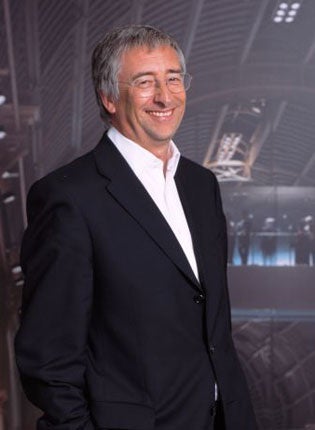Nick Terry: Architect who led the redevelopment of the Royal Opera House and the Royal Albert Hall

Your support helps us to tell the story
From reproductive rights to climate change to Big Tech, The Independent is on the ground when the story is developing. Whether it's investigating the financials of Elon Musk's pro-Trump PAC or producing our latest documentary, 'The A Word', which shines a light on the American women fighting for reproductive rights, we know how important it is to parse out the facts from the messaging.
At such a critical moment in US history, we need reporters on the ground. Your donation allows us to keep sending journalists to speak to both sides of the story.
The Independent is trusted by Americans across the entire political spectrum. And unlike many other quality news outlets, we choose not to lock Americans out of our reporting and analysis with paywalls. We believe quality journalism should be available to everyone, paid for by those who can afford it.
Your support makes all the difference.Nick Terry was a notable chairman of Building Design Partnership (BDP), the UK's largest architectural practice, and a self-effacing architect whose easy manner belied an absolute commitment to getting the job done. The flowering of his considerable managerial and technical abilities, through which he strove to integrate architecture and engineering, coincided with major cultural projects enabled by the National Lottery etc Act (1993).
His leadership of the redevelopments of the Royal Opera House (1999) and of the Royal Albert Hall (2003), although understated, was never in doubt. Confidently deflecting the considerable financial and political risks inherent in re-modelling well-loved public buildings, and avoiding professional rivalries, he led these gargantuan London projects to triumphant conclusions. Both schemes vindicate the stress placed on design quality in Lottery-funded projects by the then Conservative administration led by John Major, following an Arts Council campaign supported by Peter Palumbo, Norman St John-Stevas (Lord St John of Fawsley), Jacob Rothschild and Richard Rogers.
BDP was a significant beneficiary of the Lottery, whose investment proved an antidote to what Terry described as the "rampant commercialism" of recent decades. Twice chairman (2002-04, 2004-06) of the firm, he set out to burnish the legacy of its redoubtable founder, Sir George Grenfell-Baines (1908-2003), who had first recruited him in Manchester in 1972.
The BDP philosophy, articulated by Grenfell-Baines in 1961, was that of the "complete", multi-skilled designer working in a group effort. The firm's corporate structure had socialist, co-operative origins: Grenfell-Baines's Preston Methodist roots led him to eschew as vanity the stellar performances of individuals. Terry's personality was suited perfectly to the BDP ethos of professional modesty. His quiet charm and analytical style (accompanied by a diagram or organisational chart of his own devising) encouraged other designers: while conducting the orchestra, he would not claim credit for the efforts of all the players.
As chairman of BDP, Terry set out to reaffirm the values of what had by then become the leading multi-disciplinary design practice in the UK. By virtue of its size, turnover, and its workload of commercial and public buildings (by 1980 it employed more than 1,000 staff), BDP had grown into the de facto training ground for Britain's emerging architects. Terry made his own contribution to this legacy by establishing a BDP bursary for a female engineering or architectural student, at the Cambridge college known until recently as New Hall.
Nicholas Terry was born in 1947 and educated at Bilborough Grammar School in Nottingham. He joined Bath University's then pioneering architecture and engineering course in 1966 (where he also met his future wife, Dorothy), and his mathematical flair and logical rigour pointed as much to professional practice as a structural engineer as to a career in architecture. Leaving BDP after his first initiation under Grenfell-Baines, from 1975 to 1990 he obtained wider technical and project management experience with architects in Canada and with US firms in Europe and the Middle East. He was influenced notably by the Modernist Arthur Erickson and the engineer Tony Hunt.
Returning to BDP, he created the Cribbs Causeway shopping centre in Bristol (1998), managing to make the 100,000m2 structure appear as a piece of integrated design rather than a superficial stage set. The stunning Nike Town (2001) on Oxford Street in London (the largest such store in the world) showed on the other hand that he also knew how to placate the gods of retail (and of speed) when required. He also managed the Jubilee Place project (2003) in Docklands, an underground mall – with glazed roof providing views of the external landscape and buildings – that links directly with gardens above and Canary Wharf tube station below.
Terry was chairman (1994 to 2000) of the BDP joint venture with the architects Dixon and Jones for the re-development of the Royal Opera House, Covent Garden. The new building provided greatly improved technical, rehearsal and educational facilities and much more public space, including the reconstruction of the adjacent Floral Hall as the principal foyer. Jeremy Dixon, who received a knighthood following the project, paid tribute to Terry: "Getting two different kinds of architectural practice to work in harmony is not always easy and required his kind of generosity and depth of experience." Terry was also an ambassador for the architectural profession, serving on many industry bodies.
Rory Coonan
Nicholas John Terry, architect: born Nottingham 12 November 1947; architect, Terry Associates, Bath 1970-72; architect, Building Design Partnership, Manchester 1972-75; architect, Arthur Erickson Architects, Canada 1975-77; architect, J.S. Bonnington Partnership, St Albans 1978-81; Managing Director, Heery Architects and Engineers 1981-89; architect, Building Design Partnership, London 1990-2008, Equity Partner 1995-97, director 1997-2008, chairman 2002-06; chairman, Dixon Jones BDP 1994-2000; married 1970 Dorothy Atkins (one daughter); died Cambridge 30 November 2008.
Join our commenting forum
Join thought-provoking conversations, follow other Independent readers and see their replies
Comments